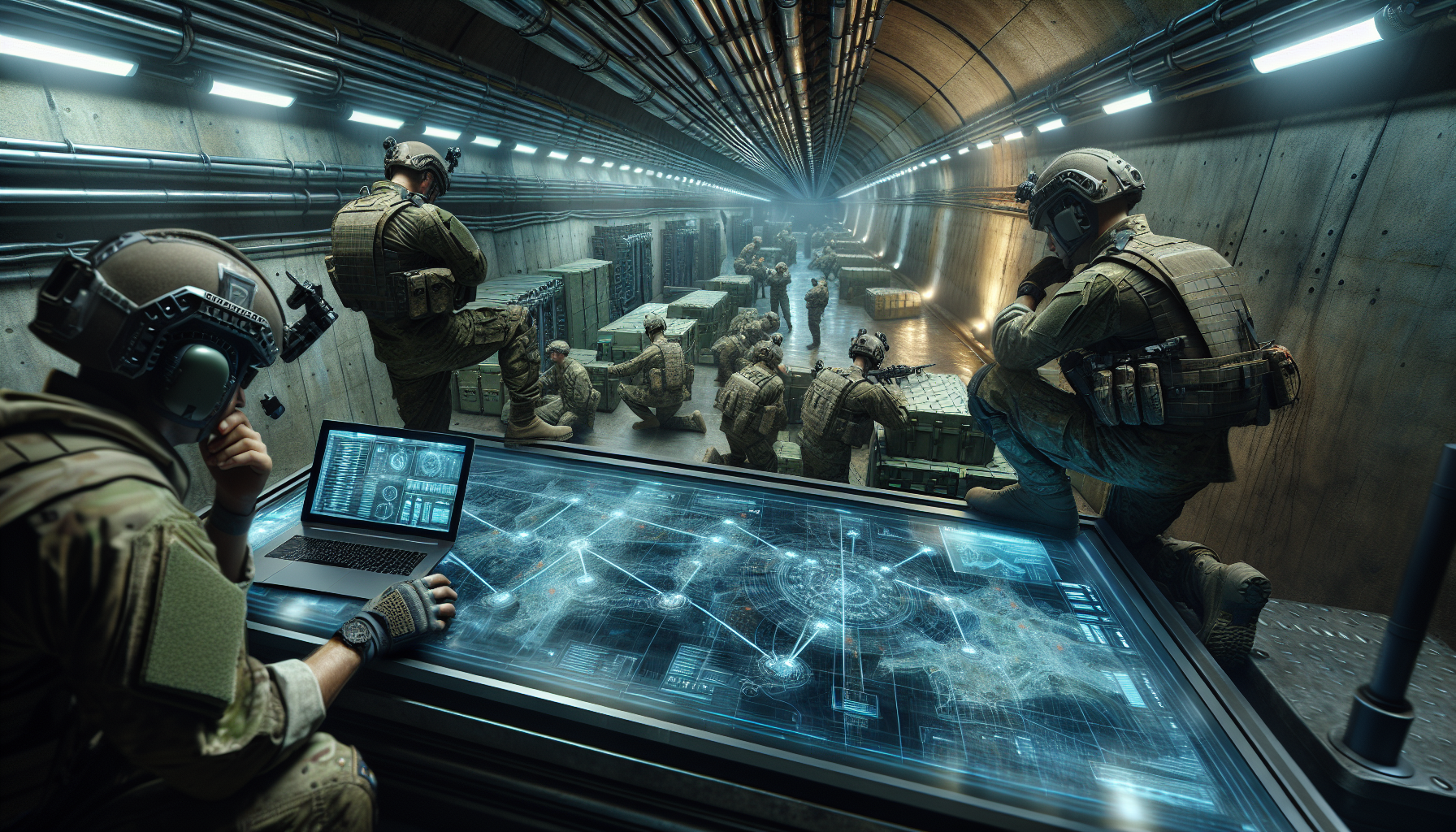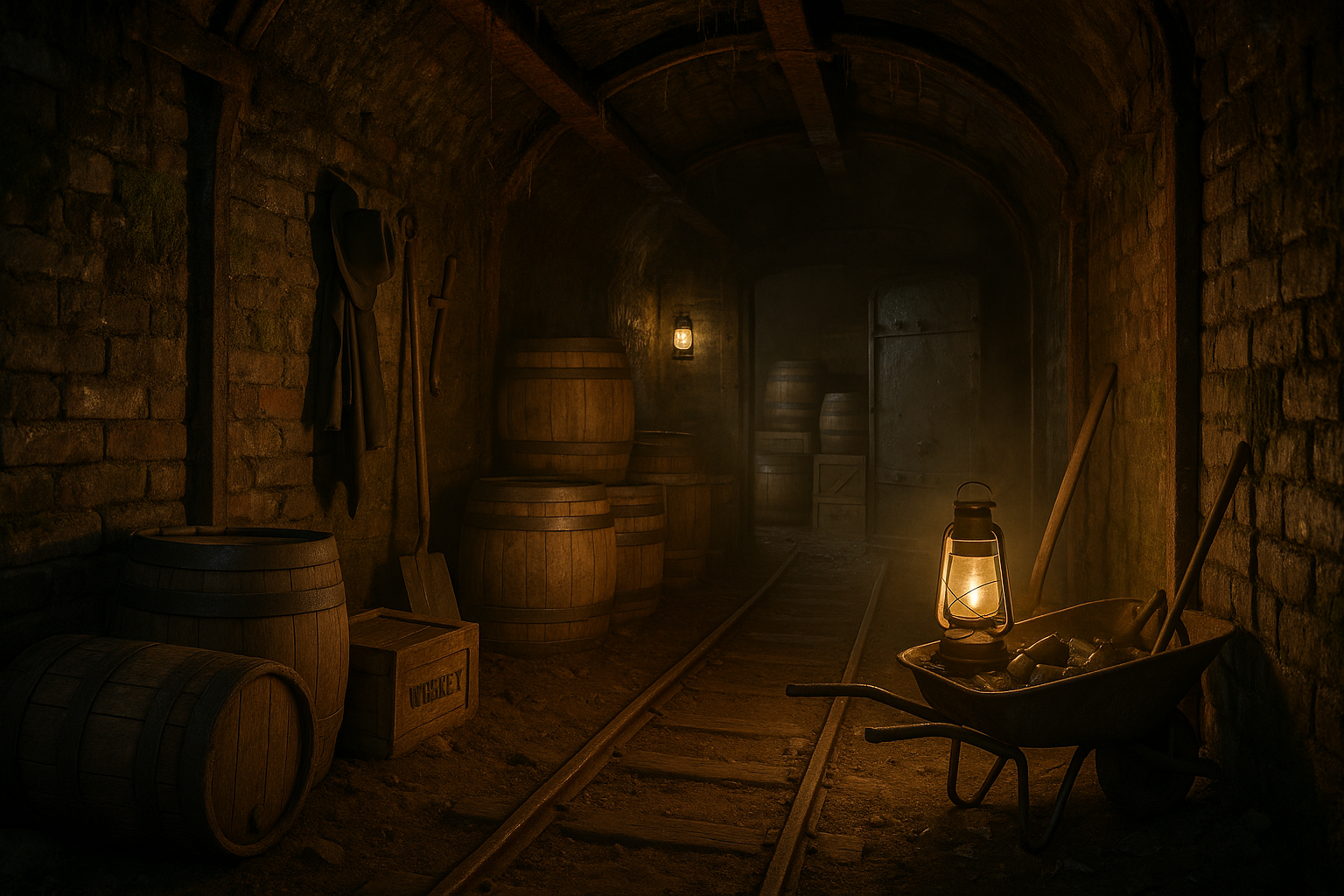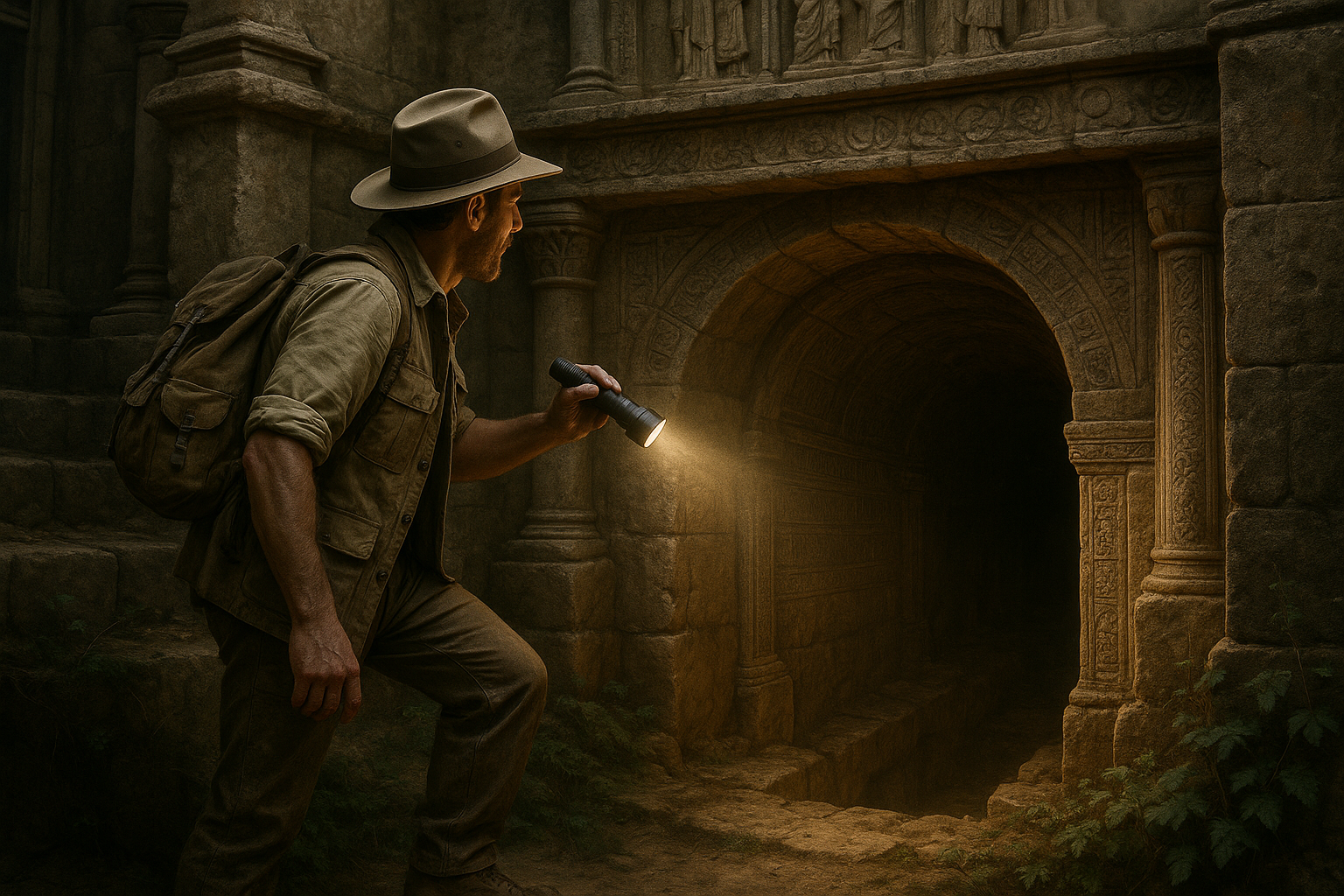In the intricate chess game of modern military operations, the board extends far beyond the surface. The underworld, often romanticized in literature and cinema, has become a critical arena in which strategic and logistical prowess are tested. As technology advances and global landscapes shift, the subterranean domain offers both challenges and opportunities for military forces worldwide. Welcome to the realm of strategic subterranean solutions—a topic that delves deep into the logistics of maintaining and maneuvering troops underground. 🌍
From ancient times, when soldiers took refuge in caves, to contemporary military operations utilizing sophisticated underground bunkers, the subterranean environment has played a pivotal role in warfare. However, today’s underground operations are not merely about sheltering troops or storing supplies. They encompass complex networks of tunnels and facilities that require meticulous planning and execution. This article aims to illuminate the often-overlooked logistics of subterranean strategies, exploring how militaries around the globe are mastering this concealed domain.
Imagine the potential of deploying troops through a hidden network of tunnels, moving unnoticed beneath the surface, with the element of surprise on their side. But this scenario isn’t just about stealth; it’s about ensuring these troops are adequately supplied, supported, and sustained in an environment that is as unforgiving as it is strategic. The logistics of such operations demand innovation, adaptability, and foresight. From ensuring communication lines are secure deep underground to managing resources in confined spaces, each element of subterranean operations poses unique challenges that require cutting-edge solutions.
In this article, we will navigate the intricate logistics involved in keeping troops underground. We will explore the technological advancements that have transformed subterranean operations—from advanced ventilation systems that ensure breathable air in the depths of the earth to state-of-the-art mapping technologies that prevent troops from getting disoriented in complex tunnel networks. Moreover, we will examine the critical role of training and preparedness, as troops must be equipped with not only physical tools but also the psychological resilience to operate in confined and potentially claustrophobic environments.
Furthermore, the discussion will extend to the geopolitical implications of subterranean operations. As nations become increasingly aware of the strategic advantages offered by underground logistics, the global military landscape is being reshaped. We will delve into case studies highlighting successful subterranean strategies, providing insights into how different militaries are adapting to this evolving domain. Whether it’s the defense tactics employed in urban warfare or the offensive strategies used in covert operations, understanding the logistics of subterranean solutions is essential for any military force looking to gain a competitive edge.
Join us as we embark on a journey beneath the surface, unveiling the strategies, technologies, and tactics that define the logistics of keeping troops underground. As we traverse this hidden world, you’ll gain a deeper appreciation for the complexities and innovations that characterize modern subterranean warfare. Get ready to explore the depths of strategic subterranean solutions, where the unseen battles unfold and the logistics of underground operations take center stage. 🚀
Introduction to Subterranean Warfare
In the modern theater of warfare, where technology and strategy evolve at a breakneck pace, the concept of subterranean warfare—using underground environments for strategic military purposes—has gained significant traction. As the landscapes of battlefields shift from open terrains to more concealed and protected environments, mastering the logistics of keeping troops underground becomes a critical component for military success. This article delves deep into strategic subterranean solutions, examining the nuances of subterranean warfare and how it shapes modern military operations.
Subterranean warfare is not a novel concept. Historically, tunnels and underground passages have been used to gain tactical advantages, whether it was to launch surprise attacks or to create safe passages away from the enemy’s line of sight. However, the complexity and scope of these operations have significantly increased with advancements in technology and engineering. The underground offers a sanctuary from aerial attacks, satellite surveillance, and even certain types of weaponry. As a result, many nations have invested heavily in developing sophisticated subterranean infrastructures that can support a variety of military activities, from troop accommodation to strategic command centers.
The core of mastering subterranean logistics lies in a comprehensive understanding of environmental conditions, engineering solutions, and logistical frameworks. Establishing a functional underground base is no small feat—it requires meticulous planning, vast resources, and coordination across multiple domains. Engineers must design structures that withstand geological pressures and potential enemy attacks while ensuring the safety and operational readiness of the troops housed within. Moreover, the logistics of supplying these bases with food, equipment, and medical supplies present unique challenges that need to be meticulously addressed.
Engineering the Underground: Structural Considerations
The engineering aspect of subterranean solutions involves a deep dive into the structural integrity and sustainability of underground facilities. One of the foremost challenges is constructing stable and secure environments that can endure both natural and man-made threats. The geological characteristics of a location play a pivotal role in determining the design and materials used in building these facilities. For instance, the type of soil, rock formations, and seismic activity in the area can influence the architectural approach significantly.
Engineers must employ advanced technologies and innovative materials to ensure the safety and durability of these structures. This includes utilizing reinforced concrete, steel reinforcements, and other cutting-edge materials that provide both strength and flexibility. Additionally, ventilation systems must be meticulously designed to ensure a constant supply of fresh air, while also providing filtration capabilities to protect against chemical or biological threats. The integration of climate control systems is equally important to maintain habitable conditions regardless of external weather patterns.
Furthermore, the strategic placement of these facilities can greatly influence their effectiveness. Some bases are built deep within mountains or beneath urban environments to provide maximum protection. Others are strategically located near critical resources or transportation networks to facilitate efficient logistics and supply chain management. These decisions require careful analysis of both the strategic objectives and the environmental constraints, ensuring that the underground facilities enhance rather than hinder military operations.
Logistical Challenges and Solutions
Logistics in subterranean environments presents unique challenges that require innovative solutions. Traditional supply chains are often disrupted in underground settings, necessitating alternative approaches to ensure the timely and efficient delivery of goods and services. One of the primary logistical concerns is the transportation of essential supplies, such as food, water, ammunition, and medical equipment, to and from underground facilities.
To overcome these challenges, military strategists have developed specialized transportation systems that can navigate the complexities of subterranean environments. These systems often involve a combination of automated vehicles, conveyor belts, and strategically placed depots to facilitate the smooth flow of supplies. Additionally, the implementation of advanced communication networks is crucial to maintaining coordination and efficiency in logistical operations. These networks enable real-time tracking of supplies and personnel, allowing for rapid response to any disruptions or emergencies that may arise.
Moreover, the storage and distribution of supplies within underground facilities require careful planning and organization. Space constraints and environmental factors necessitate the use of compact and efficient storage solutions. Modular storage units, for instance, can be easily rearranged to accommodate changing needs, while specialized refrigeration systems ensure the preservation of perishable goods. The integration of smart technologies, such as IoT devices and sensors, further enhances the management of supply chains by providing real-time data on inventory levels and environmental conditions.
Technological Innovations in Subterranean Operations
The role of technology in enhancing subterranean operations cannot be overstated. From advanced surveillance systems to cutting-edge communication networks, technology plays a pivotal role in ensuring the success of underground military operations. One of the key areas where technology has made significant strides is in the realm of surveillance and reconnaissance. The use of drones and robotic systems equipped with high-resolution cameras and sensors allows for the continuous monitoring of underground environments, providing valuable intelligence and situational awareness.
Communication in subterranean environments presents its own set of challenges due to the lack of direct line-of-sight and potential interference from surrounding materials. To address this, military forces have developed specialized communication systems that utilize low-frequency radio waves and wired networks to ensure reliable and secure communication between underground units and command centers. These systems are designed to withstand the harsh conditions of subterranean environments and provide uninterrupted connectivity, even in the event of external disruptions.
In addition to surveillance and communication, technology also plays a crucial role in enhancing the safety and efficiency of underground operations. The use of automation and robotics, for example, can significantly reduce the risk to human operators in hazardous environments. Automated systems can perform tasks such as tunneling, excavation, and maintenance with precision and efficiency, minimizing the need for human intervention. Moreover, the integration of artificial intelligence and machine learning algorithms enables the continuous optimization of operations, allowing for adaptive responses to changing conditions and threats.
Psychological and Physical Considerations for Troops
Life underground presents unique psychological and physical challenges for military personnel. The lack of natural light and confined spaces can lead to feelings of isolation and claustrophobia, impacting the mental well-being of troops stationed in subterranean environments. To address these challenges, military planners must implement comprehensive support systems that promote the mental and physical health of personnel.
The design of underground facilities plays a crucial role in mitigating the psychological impact on troops. The incorporation of natural elements, such as artificial lighting that mimics natural sunlight, and the use of open spaces can help alleviate feelings of confinement. Additionally, recreational areas and social spaces are essential for promoting camaraderie and providing opportunities for relaxation and leisure. These areas can include gyms, game rooms, and communal dining areas, fostering a sense of community and belonging among personnel.
On the physical front, maintaining the health and fitness of troops is paramount. Regular physical exercise is crucial for countering the sedentary lifestyle associated with underground environments. Military planners must ensure the availability of fitness facilities and encourage regular exercise routines to maintain physical readiness. Furthermore, a well-balanced diet and access to medical care are essential components of ensuring the overall health and well-being of personnel stationed underground.
Case Studies: Successful Subterranean Operations
Examining real-world examples of successful subterranean operations provides valuable insights into the practical application of strategic subterranean solutions. One notable case study is the extensive underground tunnel systems developed by North Korea. These tunnels, some of which stretch for miles beneath the Korean Peninsula, serve as a testament to the strategic advantages of subterranean warfare. They provide secure transportation routes, storage facilities, and even launch sites for missiles, showcasing the multifaceted capabilities of underground infrastructures.
Similarly, the Vietnam War saw the extensive use of underground tunnels by the Viet Cong. The Cu Chi tunnels, in particular, played a crucial role in the Viet Cong’s ability to conduct guerrilla warfare against superior American forces. These tunnels not only provided shelter and storage but also facilitated surprise attacks and the movement of troops, contributing significantly to the overall strategy of the Viet Cong.
The successful implementation of subterranean operations in these case studies highlights the importance of adaptability and innovation. Each scenario presented unique challenges and required tailored solutions to achieve strategic objectives. The ability to leverage the advantages of underground environments, while effectively addressing the associated challenges, is a hallmark of successful subterranean warfare.
Conclusion
In conclusion, the mastery of subterranean logistics and operations represents a crucial aspect of modern military strategy. The ability to effectively leverage underground environments offers significant strategic advantages, from enhanced protection and security to improved operational efficiency. However, the successful implementation of subterranean solutions requires careful planning, innovative engineering, and comprehensive support systems for personnel.
As the landscape of warfare continues to evolve, the importance of subterranean solutions is likely to grow. Military forces must remain vigilant and adaptable, continuously exploring new technologies and strategies to enhance their subterranean capabilities. By doing so, they can ensure their readiness and effectiveness in an ever-changing world.
For those interested in exploring this topic further, the video below provides additional insights into the strategic advantages of subterranean warfare:
Additional Resources
- Understanding Subterranean Environments: A Comprehensive Guide
- The Impact of Technology on Modern Warfare
- Case Studies in Military Strategy: Lessons from the Past
Comparative Analysis: Subterranean vs. Traditional Warfare
| Aspect | Subterranean Warfare | Traditional Warfare |
|---|---|---|
| Environmental Impact | Minimized due to underground operations | Significant, with potential for widespread damage |
| Visibility to Enemy | Limited visibility, providing strategic advantages | Highly visible, increasing vulnerability |
| Logistical Challenges | Complex due to underground constraints | More straightforward with established supply chains |
| Technological Requirements | High, with advanced systems for communication and surveillance | Moderate, with standard military technology |

Conclusion
In conclusion, the exploration of strategic subterranean solutions in mastering the logistics of keeping troops underground reveals a multifaceted domain of military operations that extends far beyond traditional battlefield tactics. Throughout this article, we’ve navigated through the intricate dimensions of underground warfare, emphasizing the need for innovative strategies, advanced technology, and adaptive training methodologies to enhance operational effectiveness in subterranean environments.
To recap, we began by highlighting the historical context of underground warfare, illustrating its evolution from ancient times to modern-day military operations. This historical perspective set the stage for understanding the strategic importance of subterranean environments in contemporary conflict scenarios. We examined the key challenges associated with subterranean operations, including navigation, communication, and environmental hazards, which necessitate specialized training and equipment for effective troop deployment.
Furthermore, we explored the role of technology in overcoming these challenges, emphasizing advancements in communication systems, surveillance, and mapping technologies that enhance situational awareness and operational coordination in underground settings. The integration of autonomous systems and robotics also emerged as a crucial component in reducing human risk and optimizing logistical operations.
Training emerged as a cornerstone for mastering subterranean logistics, underscoring the importance of specialized training programs that simulate real-world underground conditions. These programs equip troops with the skills necessary to navigate complex tunnel networks, engage adversaries effectively, and maintain operational readiness under challenging circumstances.
The discussion also extended to the ethical and environmental considerations of subterranean operations. As military forces increasingly rely on underground tactics, it becomes imperative to address potential impacts on civilian populations and the environment, ensuring that operations are conducted responsibly and in compliance with international humanitarian laws.
The strategic implications of subterranean warfare were further dissected, emphasizing its role in asymmetrical warfare and urban combat scenarios. The ability to control and navigate subterranean spaces offers a significant tactical advantage, enabling forces to surprise adversaries, protect assets, and conduct covert operations with greater efficacy.
As we conclude, the importance of mastering subterranean logistics cannot be overstated. The dynamic and often unpredictable nature of underground environments demands continuous innovation and adaptability. Military strategists and defense organizations must prioritize research and development to stay ahead of potential adversaries and safeguard national security interests.
We encourage readers to engage with the insights presented in this article. Reflect on the strategic significance of subterranean solutions and consider how these principles might apply to broader contexts within and beyond military operations. Sharing this knowledge within your networks can foster a deeper understanding of the complexities involved and stimulate dialogue on innovative solutions to emerging challenges.
In a rapidly evolving global security landscape, the ability to operate effectively in subterranean environments is not merely an advantage—it is a necessity. Let us embrace this challenge with determination, leveraging technology, training, and ethical considerations to build a future where strategic subterranean solutions play a pivotal role in ensuring peace and security.
For further reading and exploration, consider visiting reputable sources such as the RAND Corporation’s research on military operations (https://www.rand.org/topics/military-operations.html) and the Center for Strategic and International Studies for insights on defense strategies (https://www.csis.org/programs/international-security-program).
Together, let us pave the way for a more secure and informed future, where the mastery of subterranean logistics is not only a military imperative but also a testament to human ingenuity and resilience. 🌍✨
Toni Santos is a visual storyteller and artisan whose work explores the quiet power of what lies beneath. With a deep fascination for subterranean and hidden architecture, Toni uncovers the layers, voids, and forgotten spaces that shape our built environment from the shadows.
His art is a journey through the unseen — from ancient underground chambers to sealed passageways, service tunnels, and foundations buried in time. Each creation tells a story of silence, secrecy, and structure — revealing how absence and concealment can be just as meaningful as what’s visible above ground.
Whether working through visual compositions, architectural studies, or symbolic handcrafted pieces, Toni captures the soul of hidden spaces. His work bridges art and archaeology, blending design with discovery. Trained in visual design and traditional techniques, Toni creates with intention. His pieces don’t just depict — they interpret, inviting viewers to rethink what space, memory, and architecture mean when they’re hidden from view.
As the creative force behind Vizevex, Toni shares this perspective through curated visual narratives, symbolic collections, and interpretive essays that give voice to the quiet geometries beneath our feet.
His work is a tribute to:
The mystery of spaces built to be forgotten
The symbolism embedded in foundations, voids, and passageways
The timeless connection between human intention and hidden structure
Whether you’re an artist, an urban explorer, or someone fascinated by the unseen frameworks that support our world, Toni invites you into a realm where architecture becomes myth — one corridor, one layer, one buried story at a time.





